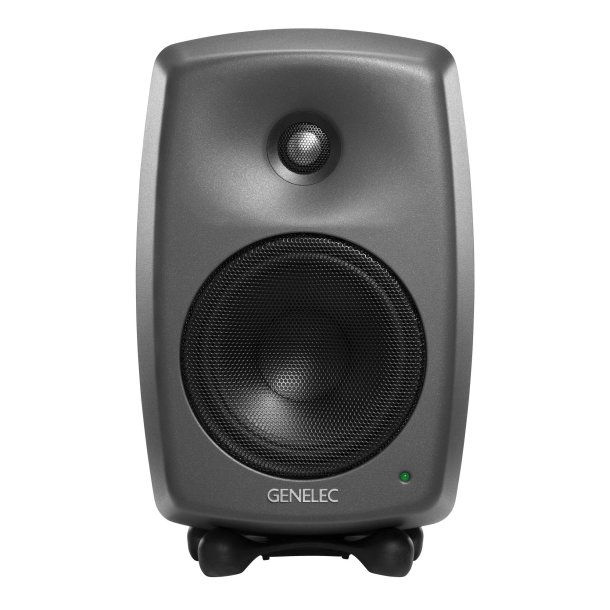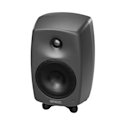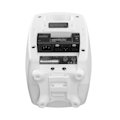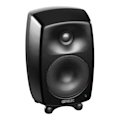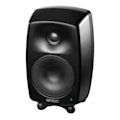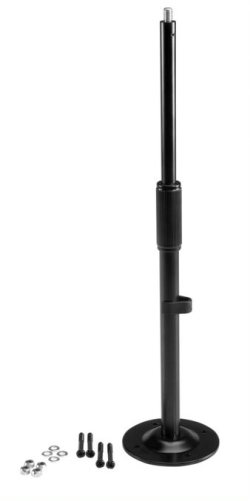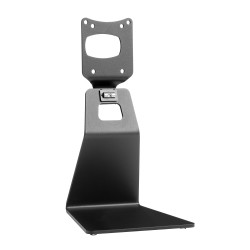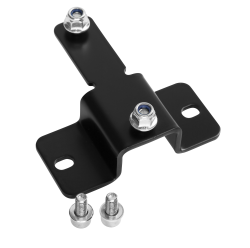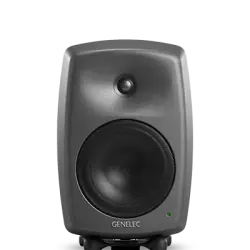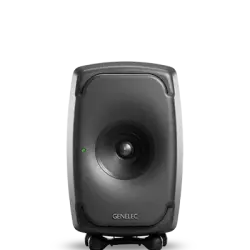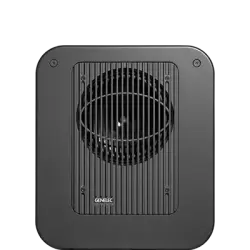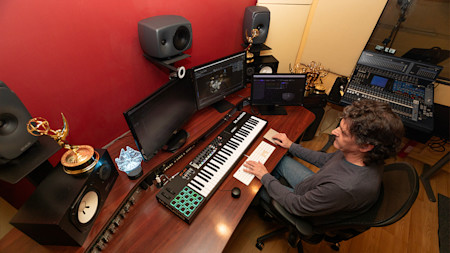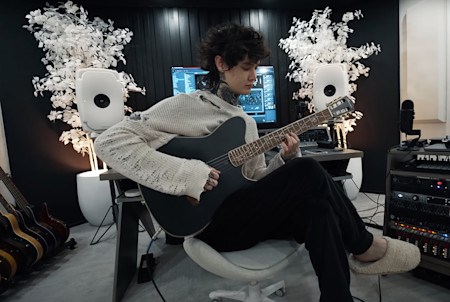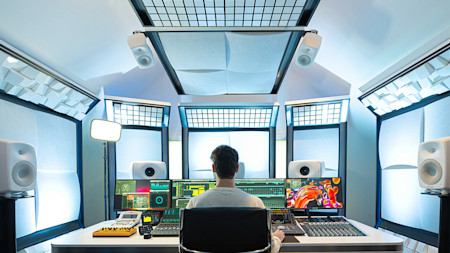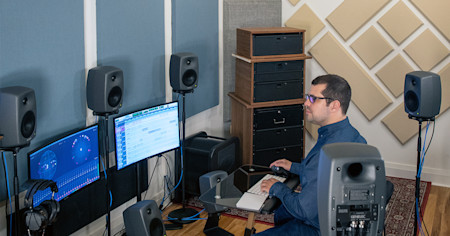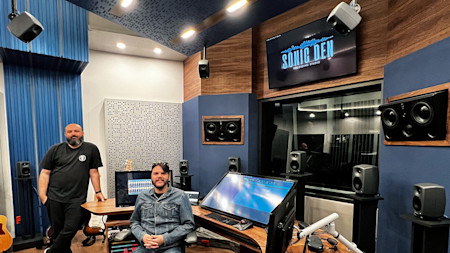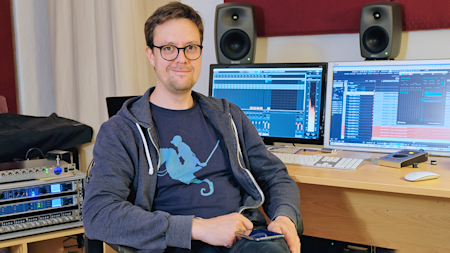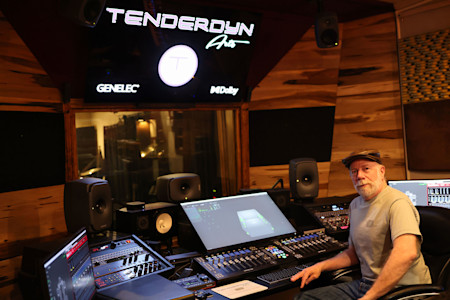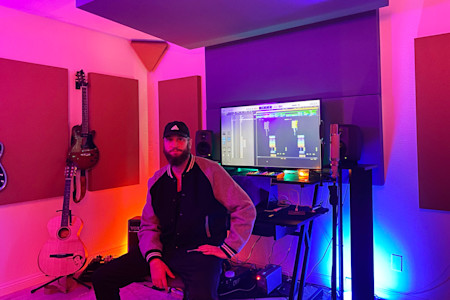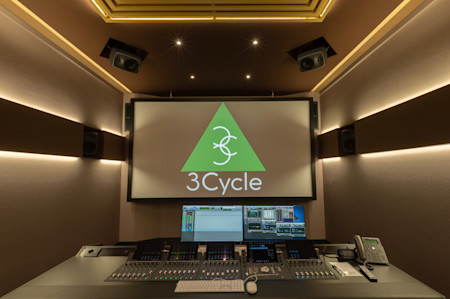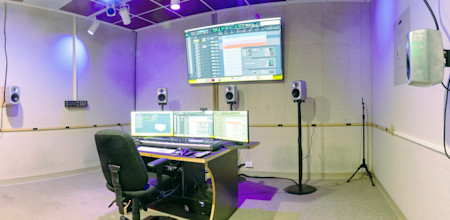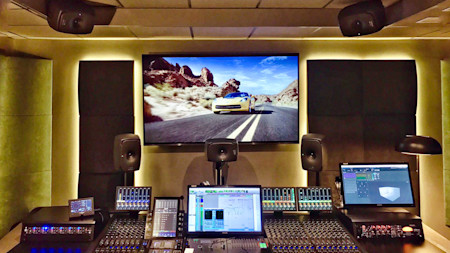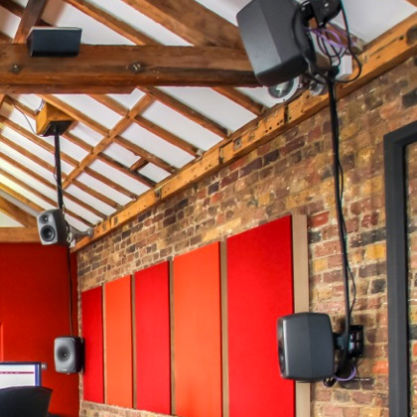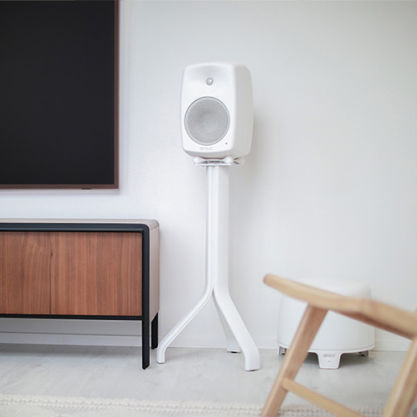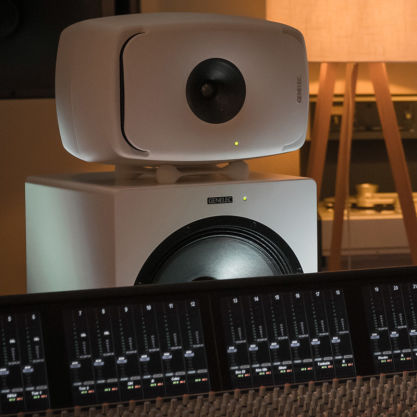Der 8330A kombiniert Präzision, Anpassungsfähigkeit und kompakte Abmessungen. Er bietet eine verfärbungsfreie Wiedergabe und leistungsstarke Funktionen zur Raumanpassung.
8330A
SAM™ Studiomonitor

Smart Active Monitor (SAM™)-Systeme

Directivity Control Waveguide (DCW™)-Technologie

SPL
104 dB

Frequenzgang
45 Hz - 23 kHz (-6 dB)

Abmessungen
H 299 x W 189 x D 178 mm, mit Iso-Pod™ (Anzeige in Inch)

Die Wahl der Profis
Der 8330A ist die erste Wahl für anspruchsvolle Profis, für die Leistung und Flexibilität Hand in Hand gehen. Er liefert etwas mehr Schalldruck und Tiefbass als das kleinere Modell 8320A. Der 8330A bietet eine transparente und wahrheitsgetreue Wiedergabe und der breite, unverfärbte Sweet Spot bedeutet, dass Sie immer in der Lage sind, genaue und zuverlässige Mischentscheidungen zu treffen.
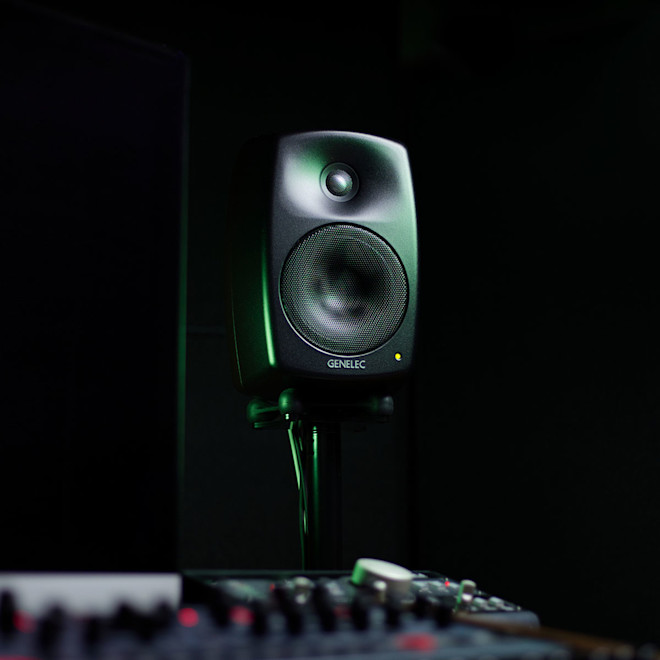
Wahrhaftig optimiertes Abhören
Als Smart Active Monitor lässt sich der 8330A mit unserer GLM-Software steuern, mit der er für Ihre Hörumgebung konfiguriert und kalibriert werden kann, um störende Raumeinflüsse zu kompensieren und eine wirklich optimierte Abhörlösung von Mono bis zu immersiven Formaten zu schaffen. Ganz gleich, ob Sie in akustisch schwierigen Räumen arbeiten oder eine mobile Lösung benötigen, die sich schnell an verschiedene Umgebungen anpassen lässt - der 8330A ist Ihr kompakter, aber cleverer Monitoring-Begleiter.
8330A
Auszeichnungen
Technische Spezifikationen

SPL
104 dB

Verstärkerleistung
50 W Bass (Class D) + 50 W Treble (Class D)

Frequenzgang
45 Hz - 23 kHz ("-6 dB")

Genauigkeit des Frequenzgangs
± 1.5 dB (58 Hz - 20 kHz)

Treiberabmessungen
⌀ 130 mm Bass + ⌀ 19 mm Treble (Anzeige in Inch)

Abmessungen
H 299 x W 189 x D 178 mm, mit Iso-Pod™ (Anzeige in Inch)

Gewicht
5.1 kg / 11.2 lb

Anschlüsse
1 x XLR Analog Input
1 x XLR AES/EBU Input
1 x XLR AES/EBU Output
2 x RJ45 Control
8330A
SAM™ Studiomonitor
Technische Spezifikationen
Der 8330A kombiniert Präzision, Anpassungsfähigkeit und kompakte Abmessungen. Er bietet eine verfärbungsfreie Wiedergabe und leistungsstarke Funktionen zur Raumanpassung.

Systemspezifikationen
Frequenzgang
58 Hz - 20 kHz (± 1.5 dB)
Low cutoff -6dB
45 Hz
High cutoff -6dB
23 kHz

SPL
Peak SPL Maximum peak acoustic output per pair at 1 m distance with music material.
≥110 dB
Kurzzeitiger max. SPL Maximum short term sine wave acoustic output on axis in half space, averaged from 100 Hz to 3 kHz at 1 m.
≥104 dB
Max. Langzeit-SPL Maximum long term RMS acoustic output in the same conditions with IEC weighted noise (limited by driver unit protection circuit) at 1 m.
≥96 dB
Eigenrauschen
Eigenrauschen Self generated noise level in free field on axis (A-weighted).
≤5 dB SPL
Gewicht
Gewicht5.1 kg (11.2 lb)
Abmessungen
Höhe
285 mm
Höhe mit Iso-Pod
299 mm
Breite
189 mm
Tiefe
178 mm
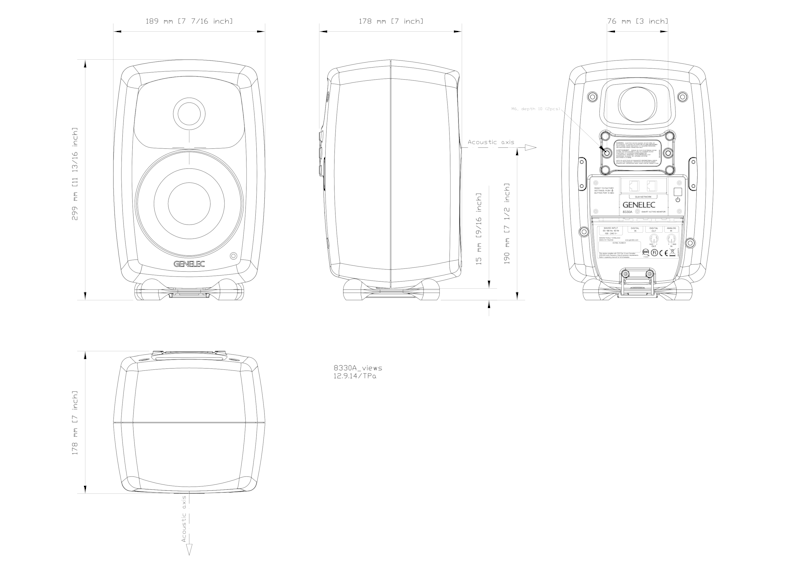
Gehäuse
Gehäusematerial
Die cast aluminium
Gehäusetyp
Reflex port
Treiber
Treiber-Typ
Cone
Durchmesser
130 mm
Treiber-Typ
Metal dome
Durchmesser
19 mm
Richtwirkung

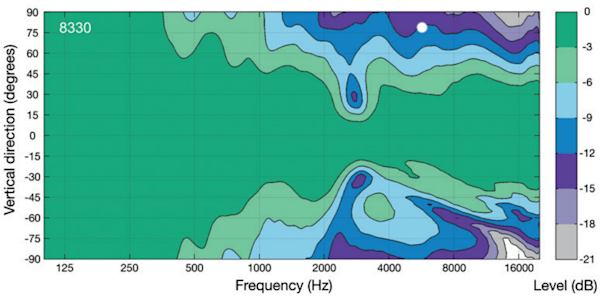
Harmonische Verzerrung
> 100 Hz ≤0.5 %
Gruppen-Laufzeit
The latency at high frequencies from the input to the acoustic output, measured in the analog input:
Extended Phase Linearity in GLM set to OFF
2.9 ms
In Genelec performance graphics, the time of converting the from an electronic input signal to the acoustic output in a Genelec monitor is described by two factors – latency and group delay. The group delay factor can be read in the graphics for a specific frequency. The total frequency-specific input-to-output delay is a sum of the latency and group delay factors. To understand the significance of this total delay, consider that moving a loudspeaker away by 1 meter creates an additional delay of about 3 ms.
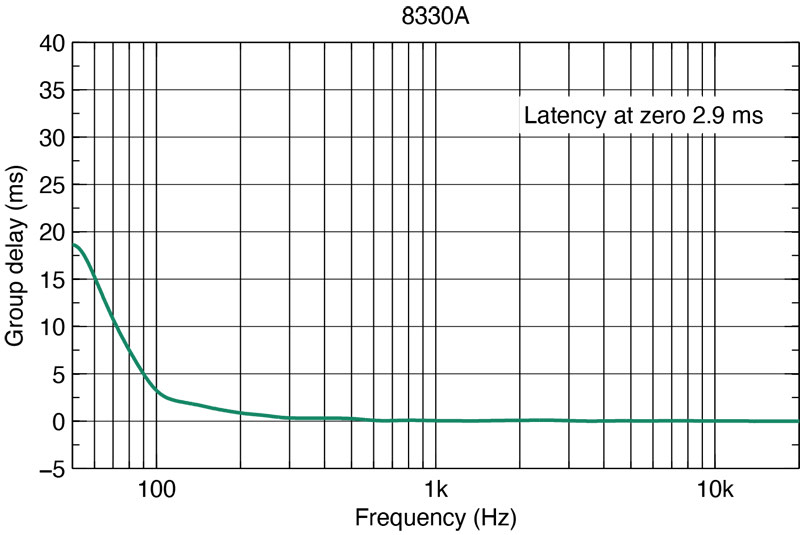
Abschnitt Verstärker
Verstärker
50 W Class D
50 W Class D
Netzspannung
100-240 VAC 50/60Hz
Stromverbrauch
ISS aktiv
≤0.5 W
Leerlauf
≤3 W
Volle Leistung
50 W
Abschnitt Signalverarbeitung
Anschlüsse
Input Analog signal input connector XLR female, balanced 10 kOhm.
Input XLR female IN
Output XLR male OUT
2 x Control Two CAT5 (RJ45) GLM Network connectors for computer control using the Genelec Loudspeaker Manager (GLM) software.
Crossover
Produktvarianten
Produktcodes
Passendes Zubehör
Produktcodes
Weitere technische Details finden Sie in der Anleitung.
Schlüsseltechnologien

Smart Active Monitor (SAM™)-Systeme

Directivity Control Waveguide (DCW™)-Technologie

Intelligent Signal Sensing (ISS™)-Technologie

Aktive Frequenzweichen

Iso-Pod™ Standfuß

Optimierte Verstärker

Schutzschaltungen

Bassreflexport-Design

Vielseitiges Montagezubehör

Minimum Diffraction Enclosure (MDE™)-Technologie
Unsere vernetzten Smart Active Monitor (SAM™)-Systeme verfügen über eine automatische Anpassung an Ihre Hörumgebung.

In den letzten zehn Jahren hat die Erstellung von Medieninhalten weltweit rapide zugenommen, was zu erheblichen Veränderungen in der Art und Weise geführt hat, wie Einrichtungen mit der gestiegenen Arbeitsbelastung umgehen. Mehr denn je findet eine wachsende Zahl von Audioproduktionen in kleineren, engeren Arbeitsumgebungen statt. Dadurch verstärken sich häufig akustische Probleme und die Zuverlässigkeit beim Abhören sinkt. Gleichzeitig muss man sich als Profi auf ein präzises Abhörsystem verlassen können, das den Klang neutral und ohne Verfärbungen wiedergibt.
Aufbauend auf den bewährten elektroakustischen Grundlagen unserer Produkte der Serien 1200, 8000 und 7000 sind die fortschrittlichen SAM-Systeme von Genelec die modernsten und flexibelsten Abhörlösungen von heute. Sie sind ein unverzichtbares Werkzeug für Audioprofis, da sie sich automatisch an die akustische Umgebung anpassen und Pegel, Verzögerungen und Frequenzgang korrigieren können. SAM-Systeme können über das Genelec-eigene Loudspeaker Manager (GLM™)-Netzwerk und die entsprechende Software gesteuert werden, so dass Sie ein äußerst flexibles und zuverlässiges Abhörsystem aufbauen können.
Die GLM-Software ist ein intuitives und leistungsfähiges Monitorsteuerungs-Netzwerksystem, das die Verbindung zu allen SAM-Studiomonitoren und Subwoofern im Netzwerk verwaltet - mehr als 80 Geräte falls notwendig. Sie ermöglicht die Einstellung von Pegeln, Abstandsverzögerungen und eine Anpassung des Frequenzgangs mit dem intelligenten automatischen Kalibrierungsalgorithmus AutoCal™. Alle Parameter und Einstellungen werden in System-Setup-Dateien oder für den Stand Alone-Betrieb in jedem einzelnen Monitor oder Subwoofer gespeichert.
Außerdem können alle akustischen Eigenschaften der SAM-Systeme für verschiedene Arbeitsstile oder Kundenanforderungen optimiert werden. Auch ween Sie zwischen verschiedenen Räumen wechseln, können Sie von der SAM-Technologie profitieren und ein Höchstmaß an Konsistenz beim Monitoring erreichen.
Genelec SAM-Systeme bieten eine umfassend skalierbare, lösungsorientierte, intelligent vernetzte Produktpalette, die analoge und digitale Signale in praktisch jeder Arbeitsumgebung unterstützt.
Directivity Control Waveguide (DCW™)-Schallführung für ausgewogene Abstrahlung auf und außerhalb der Hörachse.

Mit der Entwicklung der Directivity Control Waveguide (DCW™)-Schallführung verfolgte Genelec 1983 einen revolutionären Ansatz. Sie wurde damals in einem eiförmigen Gehäuse eingesetzt. Über 30 Jahre entwickelt und immer weiter verfeinert, verbessert sie die Leistung von direkt abstrahlenden Mehrwege-Monitoren erheblich.
Die DCW-Technologie formt die abgestrahlte Wellenfront auf kontrollierte Weise und ermöglicht so eine vorhersehbare Anpassung des Abstrahlverhaltens (Dispersion). Um eine gleichmäßige und ausgewogene Richtcharakteristik zu erreichen, wird der Abstrahlwinkel begrenzt, so dass die Streustrahlung reduziert wird. Dies führt zu einer ausgezeichneten Linearität des gesamten Frequenzgangs sowie zu einem gleichmäßigen Leistungsverhalten. Frühe Reflexionen werden minimiert und man erreicht eine breite und kontrollierte Hörzone, mit einer akkuraten Klangwiedergabe auf und außerhalb der Achse.
Geringe Erstreflexionen und eine kontrollierte, konstante Richtwirkung haben einen weiteren wichtigen Vorteil: Die Frequenzbalance des Raumschallfeldes ist im Wesentlichen die gleiche wie die des Direktfeldes der Monitore. Das hat zur Folge, dass die Leistung des Abhörsystems weniger von den raumakustischen Eigenschaften abhängig ist.
Breite und Tiefe des Klangbildes, kritische Komponenten in jeder Hörumgebung, sind nicht nur für das Hören auf der Achse, sondern auch außerhalb der Achse wichtig. Davon profitieren auch anderen Personen im Raum, die nicht im Sweet Spot sitzen, wie es in großen Regieräumen oft der Fall ist.
DCW™-Technologie Hauptvorteile:
- Lineare On- und Off-Axis-Wiedergabe für einen größeren nutzbaren Hörbereich
- Erhöhtes Verhältnis von Direkt- zu Reflexionsschall für eine geringere Verfärbung durch den Abhörraum
- Verbesserte Stereoabbildung und Tiefenstaffelung
- Erhöhte Empfindlichkeit der Antriebseinheit um bis zu 6 dB
- Erhöhte Kapazität des maximalen Schalldruckpegels des Systems
- Geringere Verzerrung des Chassis
- Geringere Beugung an den Gehäusekanten
- Geringere Verzerrung des gesamten Systems
Intelligent Signal Sensing (ISS™) zur Reduzierung des Stromverbrauchs und automatische Nutzung des Standby-Modus.

Die Anfang 2013 eingeführte Intelligent Signal-Sensing-Technologie von Genelec wurde entwickelt, um sowohl die ErP-Richtlinien der Europäischen Union als auch die umfassenderen Nachhaltigkeitsverpflichtungen des Unternehmens zu erfüllen.
Die Intelligent Signal Sensing, ISS™-Schaltung verfolgt den Signaleingang des Lautsprechers und erkennt, ob er genutzt wird. Wenn der ISS-Schaltkreis über einen bestimmten Zeitraum kein Audiosignal am Eingang findet, versetzt er den Lautsprecher in einen energiesparenden Ruhezustand und der Lautsprecher verbraucht weniger als 0,5 Watt. Wenn ein Eingangssignal erkannt wird, schaltet sich der Lautsprecher sofort wieder ein.
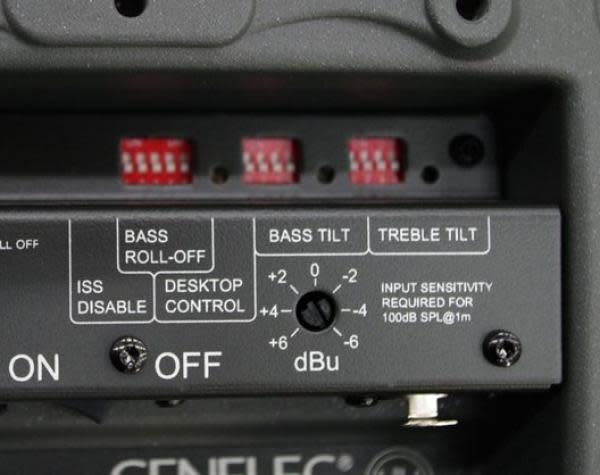
Wenn diese Funktion nicht genutzt werden soll, kann ISS™ deaktiviert werden, indem der DIP-Schalter "ISS Disable" auf der Rückseite in die Position "ON" gestellt wird. In diesem Modus wird der Monitor nur über den Netzschalter ein- und ausgeschaltet.
Beachten Sie, dass der Netzschalter den Monitor immer vollständig ausschaltet.
Nachfolgend finden Sie eine Liste der Bedingungen, die verhindern, dass der Monitor oder Subwoofer in den ISS-Ruhezustand versetzt wird:
- Am Analogeingang wird ein Signal erkannt.
- Am Digitaleingang wird ein Signal erkannt. Das kann auch das Clocking-Signal Ihrer Quelle sein, das auch anliegt, wenn kein Audio wiedergegeben wird.
- Das GLM-Netzwerk ist aktiv und GLM läuft. GLM 5 bietet eine eigene ISS Funktion an.
- ISS ist deaktiviert.
Es ist üblich, dass digitale Audioquellen das Clocking-Signal senden, sobald die Quelle eingeschaltet ist. Dies verhindert, dass der Monitor oder Subwoofer in den Ruhezustand übergeht. Es könnte auch ein Rauschen im analogen Eingangssignal vorhanden sein, das den Ruhezustand von ISS verhindert. Um herauszufinden, an welchem Eingang ein Signal anliegt, das das Umschalten in den ISS-Ruhezustand verhindert, entfernen Sie jedes Kabel einzeln und prüfen Sie, ob der ISS-Ruhezustand aktiviert wird.
Aktive Frequenzweichen, die mit niedrigen Signalpegeln arbeiten.

Elektronische Frequenzweichen ermöglichen die Aufteilung des Audiosignals in einzelne Frequenzbänder, die separat an einzelne Leistungsverstärker geleitet werden können, die dann an spezifische, für ein bestimmtes Frequenzband optimierte Wandler angeschlossen werden.
Aktive Frequenzweichen gibt es sowohl in digitaler als auch in analoger Ausführung. Die digitalen aktiven Frequenzweichen von Genelec beinhalten zusätzliche Signalverarbeitung wie Schutzschaltungen, Verzögerung und Entzerrung.
Analoge aktive Frequenzweichen von Genelec enthalten elektronische Komponenten, die mit niedrigen Signalpegeln betrieben werden, die für die Eingänge von Leistungsverstärkern geeignet sind. Dies steht im Gegensatz zu passiven Frequenzweichen, die mit den hohen Signalpegeln der Endverstärkerausgänge arbeiten und dabei hohe Ströme und in einigen Fällen auch hohe Spannungen verarbeiten müssen.
In einem typischen 2-Wege-System benötigt die aktive Frequenzweiche zwei Leistungsverstärker - einen für den Tieftöner und einen für den Hochtöner.
Das Design der aktiven Frequenzweiche bietet mehrere Vorteile:
- Der Frequenzgang wird unabhängig von dynamischen Änderungen der elektrischen Eigenschaften des Treibers oder des Treiberpegels.
- Es besteht eine erhöhte Flexibilität und Präzision bei der Einstellung und Feinabstimmung jedes Ausgangsfrequenzgangs für die verwendeten Treiber.
- Jeder Treiber hat seine eigene Signalverarbeitung und seinen eigenen Leistungsverstärker. Dadurch wird jeder Treiber von den Treibersignalen der anderen Treiber isoliert, was Intermodulationsverzerrungen und Übersteuerungsprobleme reduziert.
- Empfindlichkeitsschwankungen zwischen den Treibern können kompensiert werden.
- Frequenz- und Phasenganganomalien, die mit den Eigenschaften eines Treibers innerhalb des vorgesehenen Durchlassbereichs verbunden sind, können kompensiert werden.
- Der neutrale Frequenzgang eines hochwertigen Aktivlautsprechers ist das Ergebnis der kombinierten Wirkung des Frequenzweichenfilters, des Leistungsverstärkers und der Treiber in einem Lautsprechergehäuse.
Die Verwendung des aktiven Ansatzes ermöglicht die Anpassung und Optimierung des Frequenzgangs des gesamten Lautsprechersystems in verschiedenen Raumumgebungen ohne teure externe Equalizer. Das Endergebnis ist ein einfacheres, zuverlässigeres, effizienteres, konsistenteres und präziseres aktives Lautsprechersystem.
Der Iso-Pod™-Standfuß entkoppelt den Lautsprecher und ermöglicht die Anwinklung zur Ausrichtung.

Obwohl es ratsam ist, freistehenden Lautsprecher auf robusten und stabile Bodenstativen aufzustellen, ist es eine weit verbreitete Lösung, die Lautsprecher direkt auf einen Tisch oder ein Mischpult zu stellen.
Dies führt zu mehreren nachteiligen Nebeneffekten. Die Ausrichtung der Lautsprecherachse auf den Hörer ist nur selten möglich, außerdem übertragen sich unerwünschte mechanische Schwingungen vom Lautsprecher auf die Aufstellfläche, und die Reflexion erster Ordnung an der Arbeitsfläche führt zu Kammfilterung und damit zu Welligkeiten im Frequenzgang.
Um diese sehr häufigen Probleme zu lösen, entwickelte Genelec eine effiziente und sehr praktische Lösung. Wir entwarfen einen Lautsprecherstandfuß namens Iso-Pod™, der am Aluminiumgehäuse befestigt wird. Er hat vier flache Füße und besteht aus einem speziellen gummiartigen Material. Er kann entlang der gewölbten Boden- oder Seitenfläche verschoben werden kann, um eine Neigung des Lautsprechers von ±15° zu ermöglichen.
Die akustische Achse des Lautsprechers kann dann genau auf den Hörer ausgerichtet werden, indem die Neigung des Gehäuses mit dem Iso-Pod eingestellt wird. Die schwingungsisolierenden und dämpfenden Eigenschaften reduzieren Verfärbungen im Mitteltonbereich, die durch unerwünschte, auf die Auflageflächen übertragene Schwingungen entstehen.
Diese innovative Lösung ist ein integraler Bestandteil des Genelec-Lautsprecherdesigns und bietet klare Vorteile in Bezug auf Benutzerfreundlichkeit und Klangqualität.
Jeder Treiber wird von einem eigenen, optimierten Verstärker angesteuert.

Elektronische Frequenzweichen ermöglichen es, das Audiosignal in einzelne Frequenzbänder aufzuteilen, die separat an einzelne Leistungsverstärker geleitet werden können, die dann an spezielle, für ein bestimmtes Frequenzband optimierte Schallwandler angeschlossen werden.
In einem typischen 2-Wege-Lautsprechersystem benötigt die aktive Frequenzweiche zwei Leistungsverstärker - einen für den Tieftöner und einen für den Hochtöner. Die Leistungsverstärker werden direkt an die Chassis eines Aktivlautsprechers angeschlossen, wodurch die Belastung des Leistungsverstärkers viel einfacher ermittelt werden kann. Jeder treiberspezifische Leistungsverstärker hat nur einen begrenzten Frequenzbereich zu verstärken (der Leistungsverstärker wird nach der aktiven Frequenzweiche platziert), was die Konstruktion noch einfacher macht.
Das Aktivprinzip bietet mehrere Vorteile:
- Die Leistungsverstärker sind direkt mit den Lautsprechertreibern verbunden, wodurch die Kontrolle durch die Dämpfung des Leistungsverstärkers auf die Schwingspule des Treibers maximiert und die Folgen dynamischer Änderungen der elektrischen Eigenschaften des Treibers verringert werden. Dies kann das Einschwingverhalten des Systems verbessern.
- Der Leistungsbedarf des Endverstärkers ist geringer. Da in den passiven Frequenzweichen-Filterkomponenten keine Energie verloren geht, wird die erforderliche Verstärkerleistung erheblich reduziert (in einigen Fällen um bis zu 50%), ohne dass die akustische Leistung des Lautsprechersystems verringert wird. Dadurch können Kosten gesenkt und die Audioqualität und Zuverlässigkeit des Systems erhöht werden.
- Kein Verlust zwischen Verstärker und Treibereinheiten führt zu einer maximalen akustischen Effizienz
- Mit aktiver Technologie kann eine überragende Klangleistung im Verhältnis zur Größe und zur Leistung bei niedrigen Frequenzen erzielt werden
- Alle Lautsprecher werden als werkseitig aufeinander abgestimmtes System geliefert (Verstärker, Frequenzweichen-Elektronik und Gehäuse-Treiber-Systeme)
Hochentwickelte Schutzschaltungen für die Treiber garantieren einen sicheren Betrieb.
In kritischen Produktionsumgebungen ist es unerlässlich, dass Abhörsysteme jederzeit zuverlässig und voll funktionsfähig arbeiten. Einer der Hauptgründe für den großen Erfolg von Genelec in Rundfunk- und Fernsehumgebungen ist die Zuverlässigkeit unserer Produkte. Ein Schlüsselelement für diese Zuverlässigkeit ist die interne Schutzschaltung, die seit 1978 in allen Produkten enthalten ist.
Die Schutzschaltung verhindert Treiberausfälle, indem sie Signalpegel erkennt und bei plötzlichen Pegelspitzen oder konstant zu hohen Pegeln den Signalpegel automatisch absenkt. Natürlich beeinträchtigt diese Funktion in keiner Weise die Klangqualität der Lautsprecher, wenn sie innerhalb der Spezifikationen arbeiten, sondern verhindert nur, dass zu hohe Eingangssignale den Lautsprecher zerstören.
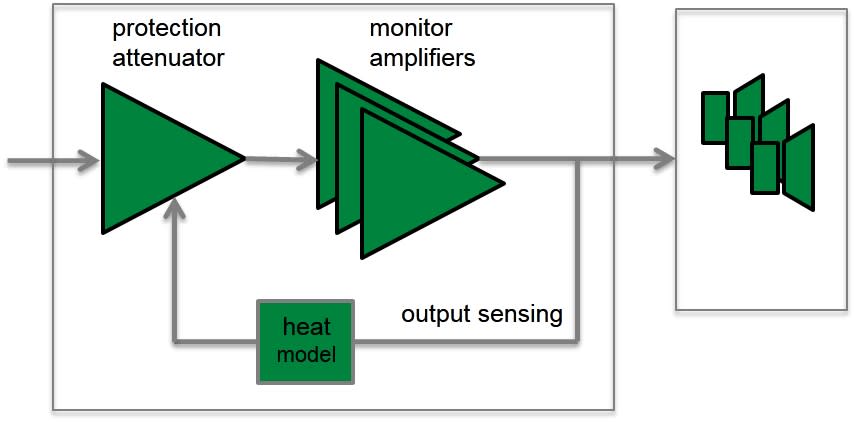
Merkmale und Vorteile der Schutzschaltungen:
- Reduziert den Ausgangspegel bei Bedarf (z. B. wenn die Temperatur der Schwingspule des Treibers den sicheren Grenzwert erreicht), was die Zuverlässigkeit des Systems erheblich verbessert
- Geeignete Schutzschaltungen in allen Lautsprechern und Subwoofern ermöglichen eine Maximierung des Systemausgangsschallpegels.
Spezielles Bassreflexport-Design für erweiterten Frequenzgang im Bassbereich.

Genelecs Entscheidung für Bassreflex-Gehäuse geht auf das Modell S30 zurück, das erste Genelec-Produkt aus dem Jahr 1978. Die Leistung der Ports wurde im Laufe der Jahre verbessert und verfeinert, um die Basserweiterung und den Schalldruckpegel des Tieftöners zu erhöhen und eine hervorragende Bassartikulation und -definition zu erreichen.
Sowohl der Treiber als auch der Port tragen zur Gesamtabstrahlung eines Reflexgehäuses bei. Der größte Teil der Abstrahlung kommt vom Treiber, aber bei der Resonanzfrequenz des Bassreflexgehäuses ist die Auslenkungsamplitude des Treibers klein und der größte Teil der Abstrahlung kommt aus der Öffnung.
Um die Luftgeschwindigkeit im Rohr zu minimieren, sollte die Querschnittsfläche der Öffnung groß sein. Das wiederum bedeutet, dass das Reflexrohr lang sein muss, was eine ziemliche Herausforderung für das Design darstellt.
Das lange, gebogene Rohr maximiert den Luftstrom, so dass tiefe Bässe ohne Kompression wiedergegeben werden können. Aus offensichtlichen Gründen endet das Reflexrohr in einer weiten Ausbuchtung auf der Rückseite des Gehäuses, wodurch Öffnungsgeräusche minimiert werden und eine hervorragende Bassartikulation gewährleistet wird.
Die Krümmung des Rohrs wurde ebenfalls sorgfältig entwickelt, um hörbare Geräusche, Kompression oder Verzerrungen zu minimieren. Das innere Ende des Rohrs hat einen geeigneten Widerstandsabschluss, um wiederum hörbare Rauschgeräusche und Luftverwirbelungen zu minimieren.
Das Design der Reflexöffnungen ermöglicht es, die Auslenkung des Tieftöners erheblich zu reduzieren und die lineare Tieftonleistung zu verbessern.
Vielseitige Montagemöglichkeiten für alle Installationsanforderungen.

Zusätzlich zum perfekten akustischen Design und den fortschrittlichen Anpassungsmöglichkeiten, um das Verhalten des Lautsprechers an die Raumumgebung anzupassen, bieten Genelec-Lautsprecher eine Vielzahl von Montagemöglichkeiten für eine einfache Installation in verschiedenen Anwendungen.
Unser breites Angebot an Zubehör und integrierte Befestigungspunkte auf der Rückseite unserer Aluminiumgehäuse bietet Lösungen für alle gängigen Einbausituationen. Für die Wand- und Deckenbefestigung sind M6-Haltepunkte in das Druckguss-Gehäuse integriert.
Einige Modelle verfügen außerdem über ein 3/8"-Gewinde an der Unterseite des Gehäuses zur Befestigung eines robusten Mikrofonständers. Andere größere und schwerere Modelle verfügen über M10-Befestigungspunkte. Für den Iso-Pod-Ständer, der Teil unseres Produktdesigns ist, wurden spezielle Stativplatten entwickelt.
Mit diesen Merkmalen haben unsere Lautsprecher ihren Weg in eine Vielzahl von Anwendungen auch außerhalb der professionellen Audio- und Studiowelt gefunden, zum Beispiel in kommerzielle und AV-Installationsprojekte sowie in private Umgebungen auf der ganzen Welt.
Gehäuse mit Minimum Diffraction Enclosure (MDE™)-Technologie für eine unverfälschte Klangwiedergabe.

Ein häufiges Problem bei Standard-Standlautsprechern ist, dass die Unregelmäßigkeiten in der Schallwand zu Beugungen führen und die scharfen Ecken des Lautsprechers als sekundäre Schallquellen wirken.
Um die Linearität des Frequenzgangs und die Leistung freistehender Lautsprechersysteme zu verbessern, hat Genelec ein hochinnovatives Gehäuse entwickelt, das auf die Eigenschaften der Monitortreiber abgestimmt ist und abgerundete Kanten sowie eine sanft gewölbte Front und Seitenwände aufweist. Neben der unübertroffenen Linearität des Frequenzgangs sorgt das Gehäuse für eine hervorragende Abbildung.
Um eine glatte und elegant gewölbte Gehäuseoberfläche zu erreichen und die Außenabmessungen des Gehäuses zu reduzieren, während gleichzeitig das Innenvolumen für einen verbesserten Wirkungsgrad im Tieftonbereich maximiert wird, haben wir ein Gehäuse aus Aluminiumdruckguss entwickelt. Aluminium ist leicht, steif und sehr einfach zu dämpfen, um eine "tote" Struktur zu erhalten. Die Gehäusewände können relativ dünn ausgeführt werden und bieten gleichzeitig eine gute EMV-Abschirmung und eine hervorragende Wärmeableitung für die Endverstärker. Der Druckguss besteht aus zwei Teilen, der Vorder- und der Rückseite, die für eventuelle Wartungsarbeiten leicht zu trennen sind.
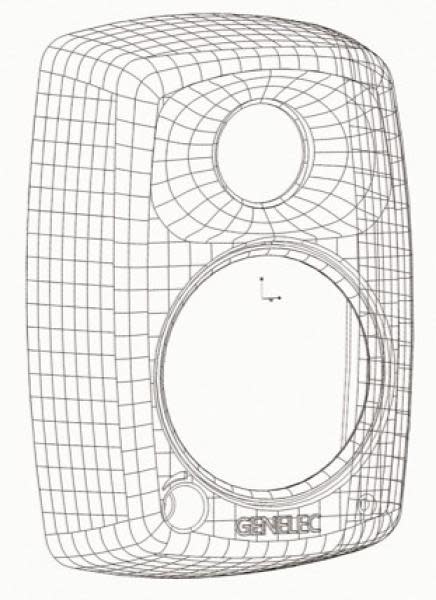
Der DCW-Waveguide wurde in das MDE-Aluminiumgehäuse integriert, um eine bessere Kontrolle über die Richtwirkung des Lautsprechers zu ermöglichen. Grundsätzlich wird die niederfrequente Grenze für eine konstante Richtcharakteristik durch die Größe der Schallführung bestimmt, d. h. je größer die Oberfläche, desto besser die Kontrolle. Mit einer sehr kontrollierten Abstrahlung auf und außerhalb der Achse wird die Hörzone konsistent, was besonders bei Mehrkanal-Anwendungen von größter Bedeutung ist. Die kontrollierte Richtwirkung reduziert auch mögliche Reflexionen erster Ordnung an Oberflächen in der Nähe des Lautsprechers und trägt so zu einer konsistenten Audiowiedergabe in unterschiedlichen akustischen Umgebungen bei. Die gesamte vordere Schallwand ist sanft gewölbt und die akustisch transparenten Schutzgitter fügen sich optisch perfekt in die verschiedenen anderen gewölbten Oberflächen ein.

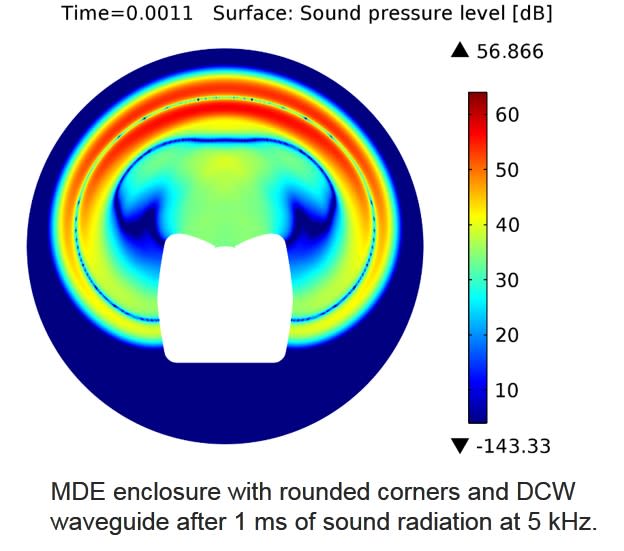
Referenzen
Genelec UNIO Explained | How the ecosystem offers seamless in-room and personal headphone monitoring
Jonna Tervomaa interview - The Art of Creating in Your Space
Using GLM | Walkthrough
Using GLM | The foundations
Using GLM | Controlling GLM with MIDI
Using GLM | GRADE Room Acoustic Report
Using GLM | Calibration Group IDs
Using GLM | Accounts and product registration
Using GLM | The technical details
Genelec UNIO Explained | How the ecosystem offers seamless in-room and personal headphone monitoring
A quick guide to our UNIO Ecosystem – which offers audio engineers seamless bridging of in-room and personal headphone monitoring. https://genelec.com/UNIO
The Genelec UNIO Ecosystem – which combines the power of our renowned GLM, SAM Monitoring and Aural ID adaptive technologies – gives audio engineers the flexibility to work anywhere, anytime, from stereo to immersive. And now, with the new UNIO Personal Reference Monitoring (PRM) solution, audio professionals benefit from the pinpoint accuracy of our pioneering active monitoring headphone solution, which combines the 9320A SAM Reference Controller with uniquely factory-calibrated 8550A Professional Reference Headphones.
To learn more, visit https://genelec.com/UNIO
Jonna Tervomaa interview - The Art of Creating in Your Space
Long-time legend of Finnish pop culture, Jonna Tervomaa, reveals the secrets of her creative process.
After first rising to musical fame in 1983 at the age of ten, Jonna began her illustrious career in earnest with her self-titled debut album released in 1998, going on to win seven Emma Gala Music Awards - the Finnish equivalent of Grammy Awards.
Her music has proven consistently popular in her native land of Finland, earning her chart success, plus platinum and gold sales.
Although mostly known for her evergreen hits ‘Suljettu Sydän’ (Closed Heart) and ‘Yhtä En Saa’ (I Won’t Get A Single One), Jonna has a diverse catalogue of fresh treasures to explore, including her first entirely English language album called ‘Fortunate Beast’.
Jonna’s creative space is powered by Genelec 8330A RAW monitors and a GLM Kit.
Discover more about Jonna on our website, click here
"The latest monitors in Genelec’s 8 series come in new APM packs, with room analysis and correction tools. We put them to the test."
-Bob Thomas, the author of the review article
{"fi-FI":"Sound on Sound Magazine's review of 8320 and 8330 studio monitors. The review was published in May 2015, and it is written by Bob Thomas.","ru-RU":"Sound on Sound Magazine's review of 8320 and 8330 studio monitors. The review was published in May 2015, and it is written by Bob Thomas.","de-DE":"Sound on Sound Magazine's review of 8320 and 8330 studio monitors. The review was published in May 2015, and it is written by Bob Thomas.","en-US":"Sound on Sound Magazine's review of 8320 and 8330 studio monitors. The review was published in May 2015, and it is written by Bob Thomas.","sv-SE":"Sound on Sound Magazine's review of 8320 and 8330 studio monitors. The review was published in May 2015, and it is written by Bob Thomas.","es-ES":"Sound on Sound Magazine's review of 8320 and 8330 studio monitors. The review was published in May 2015, and it is written by Bob Thomas.","ja-JP":"Sound on Sound Magazine's review of 8320 and 8330 studio monitors. The review was published in May 2015, and it is written by Bob Thomas."}
Händler finden

Dokumentation
Dokumente
Operating Manual 8330A Brochure 8330A SAM™ Series Full Line Catalogue In-Room Product Performance Immersive Solutions Brochure Genelec Home Studio Audio Monitoring Guide (2023) Operating Manual 8320 & 8330 - Chinese Version Genelec Home Studio Audio Monitoring Guide (German version)Downloads
Line Drawings (PDF) 8330A Line Drawings (DWG) 8330A 8330A - Simulation File (EASE3) 8330A - Simulation File (EASE4) 8330A - Simulation File (CLF)Testberichte
Sound on Sound Magazine: Genelec 8320A & 8330A APM Active Monitors & Room Calibration Kit, May 2015 (UK)FAQ
There are several improvements in the new 83xx products. The capability to adapt to the room acoustics has been improved greatly, and, for example, 8320 and 8330 products provide four to five times higher number of tools for room response compensation compared to the 82xx products. The delay alignment capability has been expanded from about 80 ms to about 200 ms in 83xx. 83xx have been time-equalized internally to have a constant input-to-output delay above 400 Hz. 83xx products can level align by 60 dB.
All 83xx and 73xx products support distributed bass management, enabling the audio signal to be passed unmodified from the source and through the subwoofer into the monitors. 73xx subwoofers support a multichannel analogue audio signal and stereo AES/EBU digital audio signal.
"The latest monitors in Genelec’s 8 series come in new APM packs, with room analysis and correction tools. We put them to the test."
-Bob Thomas, the author of the review article
Sound on Sound Magazine's review of 8320 and 8330 studio monitors. The review was published in May 2015, and it is written by Bob Thomas.

